Handgun Calibers: Uncover Bullet Size, Types, and More

Before you purchase a handgun, you should understand the uses and characteristics of all the handgun calibers available. But what exactly is a caliber, and what goes into choosing the right one? The firearm experts at Academy have put together a handgun bullet caliber size chart and comprehensive guide to everything you need to know about them to help you make the best decision.
Key Takeaways
- What is a Handgun Caliber? — Caliber is a measurement of a bullet's diameter, excluding the casing.
- Handgun Bullet Caliber Size Chart — Our handgun caliber chart covers all the features you need to know for popular calibers like the .22 LR and the .40 S&W.
- What is the Difference Between Centerfire and Rimfire Ammunition for Handguns? — The primer for centerfire ammunition is in the middle of the cartridge, while the priming compound for rimfire ammunition is in the rim.
- Full Metal Jacket vs. Hollow Point Bullets for Handguns — Hollow point bullets expand upon impact. Full metal jacket bullets are cheaper and ideal for target practice.
- How to Choose Handgun Calibers — Consider factors like intended use, recoil, your experience, ballistic performance, magazine capacity, and cost when choosing handgun calibers.
What is a Handgun Caliber?
Caliber is a measurement of a bullet’s diameter in inches or millimeters. It denotes the bullet's size and does not include the cartridge casing. Understanding caliber is essential when shopping for ammunition to ensure compatibility with your firearm.
To fully understand handgun calibers, you should familiarize yourself with a few additional key terms.
| Caliber Chart : Key Terms | ||
|---|---|---|
| Term | Definition | Special Considerations |
|
Grain is a bullet’s weight. |
Higher grain (heavier) bullets offer better wind resistance and deliver more energy to the target, but recoil from the firearm is typically greater. In contrast, lower grain (lighter) bullets achieve higher speeds and a longer range with less recoil, depending on the firearm.
|
|
|
Fragmentation |
Fragmentation refers to the process where a bullet breaks into smaller pieces upon impact. |
Frangible bullets are lighter because of the structure and materials required to support fragmentation. In general, bullets are designed to retain shape (FMJ), expand (hollow point), or fragment. |
|
Velocity |
Velocity is the speed at which a bullet travels after being discharged from the handgun. |
Bullets with higher velocity offer a flatter trajectory, which is advantageous for achieving longer distances and more accurate shots. |
|
Muzzle Energy |
Muzzle energy measures the kinetic energy of a bullet as it exits the firearm's muzzle. |
Muzzle energy also indicates a bullet’s potential power after it leaves the barrel. |
|
Penetration Depth |
Penetration depth refers to the distance a bullet travels into a target before stopping. |
Handgun calibers vary in penetration. Optimal penetration is between 12-18” per the universal standard FBI test protocol. Deeper penetration can increase effectiveness, but shallower penetration reduces the risk of damaging surroundings or harming bystanders. |
Handgun Bullet Caliber Size Chart
Popular handgun calibers include .40 S&W, .380, .32 ACP, .45 ACP, 9mm, and 10mm. These calibers serve distinct purposes and features, including:
- The .40 S&W derives from the 10mm — with less powder in the case to manage better-felt recoil. This caliber is more applicable for self-defense.
- If you want a round that is easier to conceal and handle and priced cheaper than other options, then the .380 ACP is an excellent choice!
- The .32 ACP is suitable for pocket guns and self-defense.
- The .45 ACP and 9mm are often discussed as top choices for concealed carry and home defense.
- While you CAN use the 10mm for self-defense, this caliber is almost exclusively used for hunting.
Let’s take a closer look at each handgun caliber.
| Handgun Bullet Caliber Size Chart | ||||||
|---|---|---|---|---|---|---|
| Handgun Caliber | Bullet Grain (gr) | Bullet Diameter (mm) | Velocity (ft/s) | Muzzle Energy (J) | Price Per Round (USD) | Uses |
|
30-40 |
5.7-5.73 |
1200-1600 |
140-160 |
$0.08-$0.50 |
Target shooting, small game hunting |
|
|
60-73 |
7.82 |
800-905 |
100-129 |
$0.60-$1.55 |
Concealed carry |
|
|
90-95 |
9 |
1000 |
275 |
$0.44-$2.00 |
Concealed carry, self-defense |
|
|
115-147 |
9.01 |
1000-1300 |
500-600 |
$0.29-$2.25 |
Concealed carry, self-defense, target shooting |
|
|
155-180 |
10.2 |
1000-1200 |
575-650 |
$0.44-$2.30 |
Self-defense, law enforcement |
|
|
230 |
11.4 |
900-1000 |
500-700 |
$0.50-$2.50 |
Self-defense, law enforcement |
|
|
180 |
10.17 |
1000 |
750 |
$0.60-$2.25 |
Hunting, self-defense |
|
|
120-200 |
9.1 |
675-989 |
200-320 |
$0.50-$2.25 |
Concealed carry, self-defense |
|
|
125-180 |
9.1 |
1200-1500 |
700-1050 |
$0.60-$2.20 |
Hunting, self-defense |
|
|
180-340 |
10.9 |
1180-1475 |
1600 |
$1.00-$2.50 |
Hunting, self-defense |
|
Expert Tip:
Caliber also determines a handgun’s frame size. 9mm and .40 S&W share a frame size, but .45 ACP and 10mm generally require a larger overall frame, even if the pistol looks the same.
.22 Long Rifle
The .22 LR caliber is versatile and suitable for pistols, revolvers, and rifles. It's an excellent choice for beginners due to its gentle recoil and affordability.
- This small but widely used round is known for its low-cost ammunition.
- It uses rimfire ammunition, which is less reliable and not ideal for self-defense scenarios.
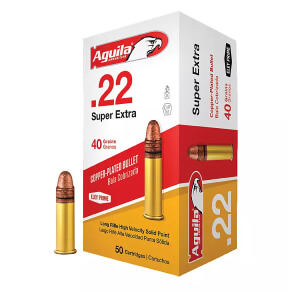
.32 ACP
The .32 ACP was developed by John Browning in 1899. Despite its lack of power and limited penetration, it can be used for home defense purposes.
- The .32 ACP is known for its low recoil — making it easy to handle for beginners.
- Typically found in compact and lightweight firearms — making it suitable for concealed carry.
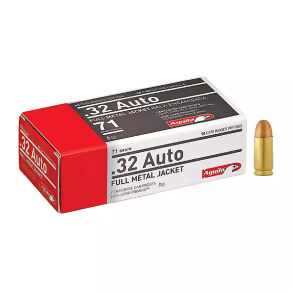
.380 Auto
The .380 Auto is nicknamed the 9mm short because of its casing length. This caliber has a diameter of 9x17mm. It's a compact handgun caliber created by John Browning.
- Nowadays, firearm owners more frequently use this caliber for self-defense.
- This caliber remains a popular option for use in small pocket pistols.

9mm
The 9mm is a military caliber — meaning supply typically stays high. Both law enforcement and the military use this caliber. It’s also a fantastic self-defense option.
- The steady supply keeps this ammo inexpensive due to being one of many military calibers.
- The 9mm has a gentler recoil than other calibers (depending on firearm size), which is great for beginners shopping for a revolver or pistol.
- The 9mm comes in a wide variety of weights so you can choose a weight based on your needs.
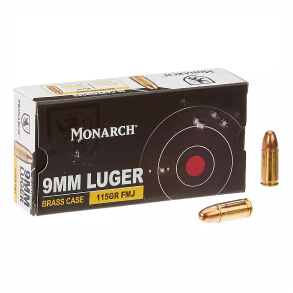
Expert Tip:
Did you know that grain has a significant impact on whether a round is subsonic (moves slower than the speed of sound, which is about 1,126 ft/s)? Subsonic rounds prevent any ‘cracking’ when fired.
.40 Smith & Wesson
The .40 S&W is seen as a cross between the 9mm and the .45 ACP. It offers faster velocity than the .45 ACP and more recoil than the 9mm.
- The .40 S&W has a good amount of stopping power — making it reliable for self-defense.
- The .40 S&W was created for the FBI and is still used by some law enforcement agencies today.
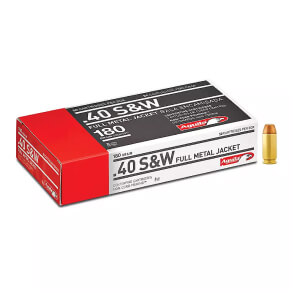
Expert Tip:
The focus for .40 S&W has always been on velocity, but its terminal ballistics are similar to modern 9mms. Because of this, the .40 S&W is being replaced by the 9mm in government agencies.
.45 ACP
The .45 ACP was designed by John Browning and originally debuted in 1911. It was used in both World War I and II — earning some serious bragging rights.
- Shooters over the age of 55 typically prefer this caliber for home defense, thanks to its reduced penetration.
- Some gun enthusiasts believe the .45 ACP has more accuracy and stopping power compared to other handgun calibers.
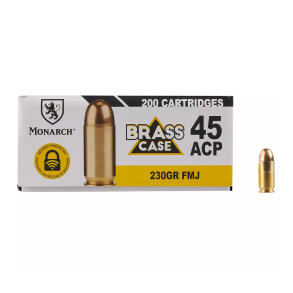
10mm
Created in the 1980s, the 10mm delivers substantial power and is likened to the .44 Magnum. It has a faster velocity than the .45 ACP.
- The 10mm is lightweight and features a high recoil — making it ideal for self-defense.
- It is useful when hunting large game or protecting against grizzly bears.
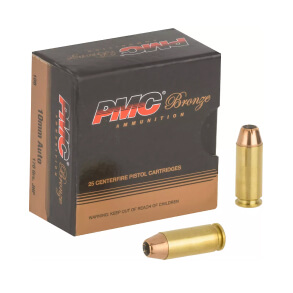
.38 Special
The .38 Special is a popular choice for revolvers and can be used in a .357 Magnum. When shopping for this ammo, it’s important to differentiate it from .380 ACP.
- Known for accuracy and versatility, this caliber is suitable for everything from self-defense to hunting small game.
- The .38 special has a manageable recoil, which is good for beginners.
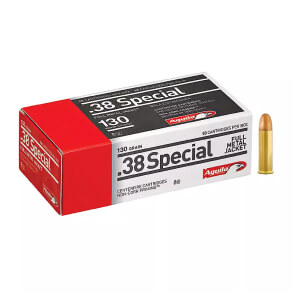
Expert Tip:
The .38 Special is a popular, cheaper alternative to the .357 Magnum for training and range days.
.357 Magnum
The .357 magnum is a revolver round with a high muzzle velocity. The sheer power of this caliber means that firing it in smaller revolvers will sting your hand.
- When used in larger firearms, this caliber makes for a serious self-defense weapon or even a hunting round.
- You can shoot a .38 Special in .357 Magnum revolvers, but not the opposite.
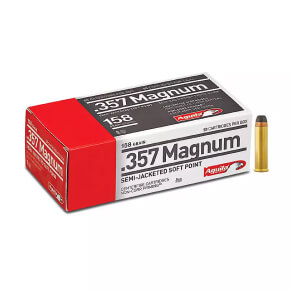
.44 Magnum
The .44 magnum is highly versatile. It can be used for everything from target practice to big game hunting and self-defense.
- The .44 has a stronger recoil than the .45 ACP — which may make it more unwieldy.
- The .44 caliber works well for protecting against bears.
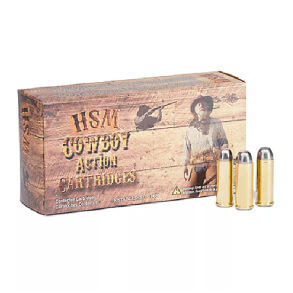
What is the Difference Between Centerfire and Rimfire Ammunition for Handguns?
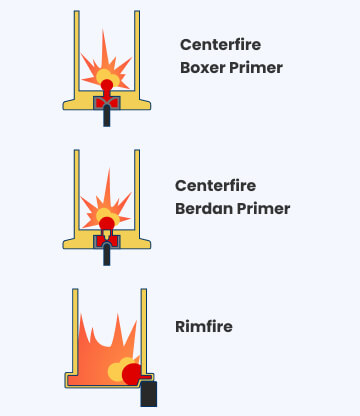
Centerfire and rimfire ammunition represent two distinct primer-ignited cartridge designs. In centerfire ammunition, the primer is located in the middle of the cartridge, while rimfire ammunition houses the primer in the rim.
Full Metal Jacket vs. Hollow Point Bullets
Hollow point and full metal jacket (FMJ) bullets are the two most popular types of bullets for handguns. Hollow point ammunition expands upon impact to increase the round’s damage potential. Conversely, full metal jacket bullets have a lead core encased in a harder metal shell. We’ve outlined their key characteristics below.
| FMJ vs Hollow Point Bullets | ||
|---|---|---|
| Category | Full Metal Jacket | Hollow Point |
|
Impact Expansion |
Does not expand |
Expands |
|
Use |
Target shooting |
Self-defense |
|
Cost |
Usually cheaper due to a less complex manufacturing process |
More expensive due to a more complex manufacturing process |
|
Ballistic Performance |
More consistent and less deformation |
Increased damage potential |
A less popular handgun bullet is the expanding full metal jacket (EFMJ). EFMJ is an alternative to hollow point bullets because it expands upon impact. It contains a polymer insert and a pre-scored jacket. This design causes a wider cavity and reduces penetration without fragmentation.
How to Choose Handgun Calibers
With so many caliber sizes for handguns available, it can be tricky to narrow down the right caliber for your needs. Consider the following factors to pinpoint the right caliber for you.
- Intended Use: Will you use your handgun caliber for self-defense, concealed carry, or hunting? The 9mm is great for self-defense, while the .44 Magnum is ideal for hunting large game.
- Your Experience: Are you a beginner or more experienced? A .45 ACP is better suited for more advanced shooters due to its powerful recoil. Stick with caliber options like the 9mm and .38 Special if you’re a beginner.
- Recoil: This affects your ability to handle the pistol, as well as accuracy. Your performance can be negatively affected if the recoil is too strong.
- Ballistic Performance: Bullet penetration between 12-18” is optimal. This causes an effective strike while minimizing risk to innocent bystanders. Certain bullets increase damage, such as hollow points that expand.
- Magazine Capacity: If you’re using your pistol for self-defense, pay attention to how many rounds it holds. You might be better off with a magazine capacity of 17 compared to 10 if you want a handgun for self-defense.
- Cost: The .22 LR offers the cheapest ammunition. Consider the price of ammo if you’re a beginner and want to practice shooting.
Expert Tip:
Heavier bullets generally result in more recoil to travel long distances. For example, a .45 ACP does not travel as far as a 9mm.
What is the most popular pistol caliber?
The 9mm is one of the most popular pistol calibers. A full-size 9mm handgun has a 17-round magazine capacity. Firearms that use this caliber tend to have lighter recoil and offer faster follow-up speed between shots.
Is a .38 Special the same as a .380 ACP?
The .38 Special and the .380 ACP are not the same type of bullet. The .38 special is used in revolvers, while the .380 ACP is used in semi-automatic pistols. To learn more about them, check out our handgun bullet caliber size chart.
Does ammo caliber affect recoil?
Recoil is more closely related to the size of the firearm than ammo caliber. The Sig Sauer P365 is a micro-compact pistol. It’s very snappy! However, a GLOCK 34 (G34) is a full-size long-slide handgun with a gentler kickback. Smaller-framed pistols usually don’t have the mass to absorb recoil as much as larger ones.
Handgun calibers — like the 9mm — vary in power, which can affect recoil. However, increasing the size of your handgun generally reduces the kickback you experience when shooting.
Have Fun Out There!
Ready to take the perfect handgun home? At Academy, you can shop for handguns by caliber and enjoy top brands like Glock and Sig Sauer. From self-defense to hunting, we’ve got the right caliber for your shooting needs. Don't forget to replenish your ammunition supply for more target shooting practice.


